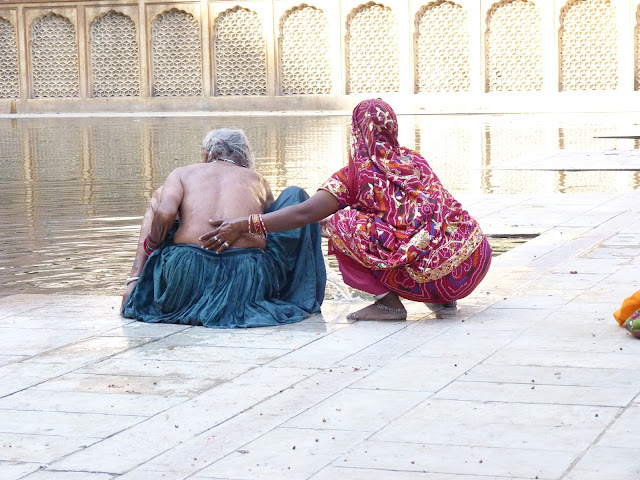The girls had a long weekend for the Mahatma Ghandi’s birthday so we took the opportunity to visit the heartland of the Indian Republic, Delhi, Agra and Jaipur.
That afternoon we went into Jaipur for lunch passing the Palace of the Winds, designed for the many ladies of the court to view parades without exposing them to the public. Along the roads we saw many elephants, camels, horses, donkeys and monkeys. Enough for Ada to tally them for her statistics homework.
 |
| Elephants on the move in front of the Palace of the Winds |
 |
| Local Sardu |
The next day we drove to Agra via the Step Well at Chand Baori. Step Wells, as opposed to the more familiar well with a narrow straight shaft, allow multiple people to walk down to the level of the subterranean water to fill their buckets.
 |
| 8th Century stairs of the step well leading to the water |
 |
| Hard to take a bad photo |
 |
The step well complex was complete with pumps
and performance platforms |
This is an elaborate example from the 7
th century complete with animal powered pumps, dancing platforms and a tunnel linking it to a nearby temple.
The light plays on each part of the well and any photograph is worthy of display. Escher would be proud of the way the lines play out in the minds eye.
The following day we set out at 0630hrs for the Taj Mahal, one of the wonders of the world, with a grumpy teenager seemingly intent on diminishing the experience for everyone else. It is, needless to say, spectacular. While the precious stone inlay and some of the architectural features are amazing up close, it is from a distance that it at its most awe inspiring. From my ill informed perspective, there is just something about the proportions of the minarets and domes that make it elegant and timeless.
 |
| Precious stone inlaid |

 |
Our cantankerous companions plotting our downfall
but at least they were talking to each other! |
 |
| Entry to the Agra Fort |
Following the Taj we returned Lucy and Ada to the hotel pool while Kate and I went visit the Agra Fort. The Agra Fort was initially constructed in 1080 and then develop by a series of rulers who jostled for power at this crossroads of India.

Despite now seeing a number of Murghul influenced Forts from this period, the innovation in terms of layout, lighting, and cooling is always amazing. What was even better was that, compared to the Taj, there were few tourists and no western tourists which always makes sightseeing a little more intimate and special.
 |
| The Taj through the pollution |

That afternoon we drove to Delhi along the newly completed Yamuna Expessway, a new toll road that cuts road travel time from six to three hours. The three lane road was almost deserted due to the 350 rupee ($6.20 AUD) toll.
 |
The Fort included wet and dry moats
with the dry moat containing tigers and snakes |
It looked and felt like an autobahn although the speed limit was only 100kmph. The major difference with the autobahn was some of the traffic as there were several examples of villagers who had obviously shared the toll and were on a day’s outing on the new expressway in a trailer hauled by a tractor.
 |
| Some of the fine detail |
The final day in Delhi saw us visit the Red Fort, once again an elegant example of Murghal design built in 1648 by Shah Jahan, who commissioned the Taj.
 |
A nice spot to while away the time with your
assault rifle |
However, in this case, the flow of the grounds and the buildings were broken by the utilitarian 19
th century British Army Barracks that had been built after the Indian Mutiny in 1857.
A short but very bumpy rickshaw ride took us to Jama Musjid, the main mosque in Delhi built at the time of the Red Fort. Although a spectacular example of Murghul architecture, Ada was more impressed by the rayon sack that Kate had to wear to ensure her modestly in the mosque. At this point we had reached the Mosque/Fort/Tomb/Step limit for Ada and a brief visit saw us retreat to the cool of the hotel pool.
































